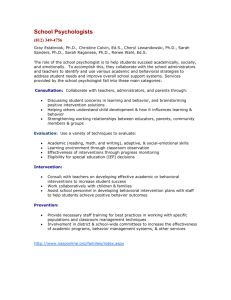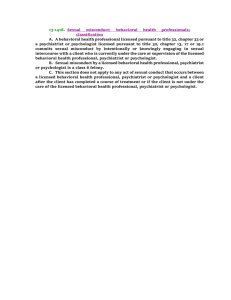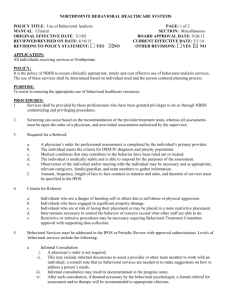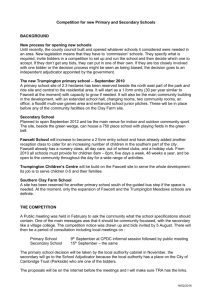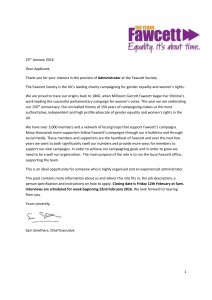HDFL 940
advertisement
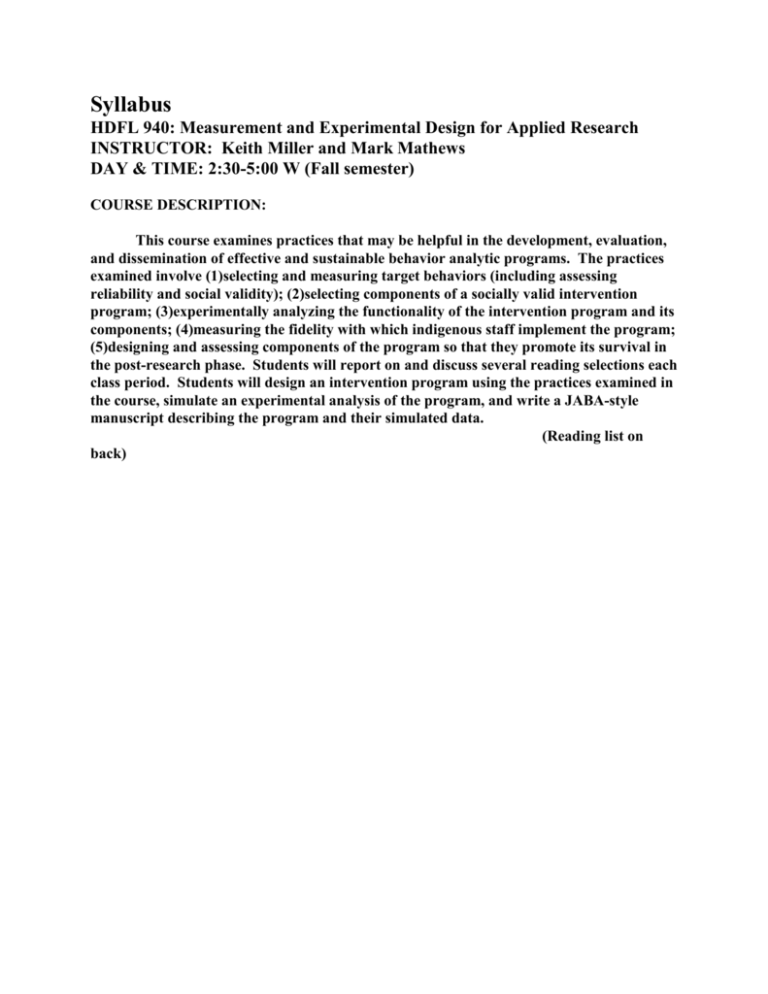
Syllabus HDFL 940: Measurement and Experimental Design for Applied Research INSTRUCTOR: Keith Miller and Mark Mathews DAY & TIME: 2:30-5:00 W (Fall semester) COURSE DESCRIPTION: This course examines practices that may be helpful in the development, evaluation, and dissemination of effective and sustainable behavior analytic programs. The practices examined involve (1)selecting and measuring target behaviors (including assessing reliability and social validity); (2)selecting components of a socially valid intervention program; (3)experimentally analyzing the functionality of the intervention program and its components; (4)measuring the fidelity with which indigenous staff implement the program; (5)designing and assessing components of the program so that they promote its survival in the post-research phase. Students will report on and discuss several reading selections each class period. Students will design an intervention program using the practices examined in the course, simulate an experimental analysis of the program, and write a JABA-style manuscript describing the program and their simulated data. (Reading list on back) References Azrin, N. H. (1977). A Strategy for Applied Research: Learning Based but Outcome Oriented. American Psychologist, 140-148. Baer, R. (1989). Maintenance of child behavior change: What happens after the experimenters leave? Education and Treatment of Children, 12, 190-199. Bassett, J. E. & Blanchard, E. B. (1977). The effect of the absence of close supervision on the use of response cost in a prison token economy. Journal of Applied Behavior Analysis, 10, 375-379 Campbell, D. T. & Stanley, Julian C. (1963). Experimental and Quasi-Experimental Designs for Research. Boston: Houghton Mifflin Company. Fawcett, S. B. (1991). Some values guiding community research and action. Journal of Applied Behavior Analysis, 24, 621-636. Fawcett, S. B., Mathews, R. M., & Fletcher, R. K., (1980). Some promising dimensions for behavioral community psychology. Journal of Applied Behavior Analysis, 13, 505-518. Hart, B. & Risley, T. R. (1995). Meaningful Differences in the Everyday Experience of Young American Children. Baltimore: Paul Brookes Publishing Company. Johnston, J. M. & Pennypacker, H. S. (1993). Strategies and Tactics of Behavioral Research, 2nd Ed., (pp. 3-14). Hillsdale: Lawrence Erlbaum Associates, Publishers. Johnston, J. M. & Pennypacker, H. S. (1993). Readings for Strategies and Tactics of Behavioral Research. Hillsdale: Lawrence Erlbaum Associates, Publishers. Liberman, R. P. (1980). A Review of Paul and Lentzs Psychological Treatment for Chronic Mental Patients: Milieu Versus Social-Learning Programs. Journal of Applied Behavior Analysis, 13, 367-371. Miller, L. K. (1996). Reinforcing Research Behavior: How to write articles for behavioral journals. Lawrence, KS: Mimeo. Osborne, D. & Gaebler, T. (1992). Reinventing Government: How the Entrepreneurial Spirit is Transforming the Public Sector. New York: Penguin Books. Peterson, L., Homer, A. L., & Wonderlich, S. A., (1982) The integrity of independent variables in behavior analysis. Journal of Applied Behavior Analysis, 15, 477-492. Poling, A. & Grossett, D. Basic Research Designs in Applied Behavior Analysis, 7-27. Reppucci, N. D. & Saunders, J. T. (1974). Social Psychology of Behavior Modification: Problems of Implementation in Natural Settings. American Psychologist, 649-660. Risley, T. R. (1998). Positive Behavioral Support and Applied Behavior Analysis. Schreibman, L., Koegel, R. L., Charlop, M. H., & Egel, A. L. (1990). Infantile Autism. International Handbook of Behavioral Modification and Therapy, 763-789. Schwartz, I. S. & Baer, D. M. (1991). Social Validity Assessments: Is Current Practice State of the Art? Journal of Applied Behavior Analysis, 24, 189-204. Seekins, T. & Fawcett, S. B. Toward an Implicit Technology of Dissemination. Skinner, B. F. (1984). The Shame of American Education. American Psychologist, 39, 947-954. Williams, D. A. & Monroe, S. (1985). The McDonalds of Teaching. Newsweek. Welsh, Miller, & Altus, (1994). Programming for survival: A meeting system that survives 8 years later. Journal of Applied Behavior Analysis, 27, 423-433. Wolf, M. M. (1978). Social Validity: The Case for Subjective Measurement or How Applied Behavior Analysis is Findings its Heart. Journal of Applied Behavior Analysis, 11, 203-214. Wolf, M. M., Giles, D. K., & Hall, R. V. (1967). Experiments with Token Reinforcement in a Remedial Classroom. Behavior Research and Therapy, 6, 51-64. Wolf, M. M., Kirigin, K. A., Fixsen, D. L., Blasй, K. A., & Braukmann, C. J. (1995). The TeachingFamily Model: A Case Study in Data- Based Program Development and Refinement (and Dragon Wrestling). Journal of Organizational Behavior Management, 15 , 11-67.
